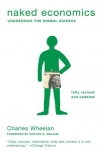Naked Economics Wheelan, Charles (books to read for 13 year olds TXT) 📖

Book online «Naked Economics Wheelan, Charles (books to read for 13 year olds TXT) 📖». Author Wheelan, Charles
There was just one problem: The Hope Scholarships had no hope of working, at least not without a large, ongoing government subsidy. The problem was a crucial asymmetry of information: Students know more about their future career plans than loan administrators do. College students never know their future plans with certainty, but most have a good idea whether their postgraduation income will be more or less than average—which is enough to determine if a Hope Scholarship would be more or less expensive than a conventional loan. Aspiring Wall Street barons would avoid the program because it’s a bad deal for them. Who wants to pay back 1.5 percent of $5 million every year for fifteen years when a conventional loan would be much cheaper? Meanwhile, the world’s future kindergarten teachers and Peace Corps volunteers would opt in.
The result is called adverse selection; future graduates sort themselves in or out of the program based on private information about their career plans. In the end, the program attracts predominantly low earners. The repayment calculations, based on the average postgraduation salary, no longer apply and the program cannot recover its costs. One may assume that Mr. Clinton ignored what his advisers almost certainly told him about the Yale experiment: It was quietly canceled after five years, both because repayments fell short of projections and because the administrative costs were prohibitive.
What we don’t know can hurt us. Economists study how we acquire information, what we do with it, and how we make decisions when all we get to see is a book’s cover. Indeed, the Swedish Academy of Sciences recognized this point in 2001 by awarding the Nobel Prize in Economics to George Akerlof, Michael Spence, and Joseph Stiglitz for their seminal work on the economics of information. Their work explores the problems that arise when rational people are forced to make decisions based on incomplete information, or when one party to a transaction knows more than another. Their insights are relevant to some of our most pressing social issues, from genetic screening to discrimination in the workplace.
Consider a small law firm interviewing two job candidates, one male and one female. Both candidates are recent Harvard Law School graduates and are eminently qualified for the position. If the “best” candidate for the job is the one who will earn the most money for the firm, which seems a reasonable assumption, then I will argue that the rational choice is to hire the man. The interviewer has no specific information on the family plans of the candidates at hand (and is forbidden by law from asking about them), but can make a reasonable inference based on what everyone knows about America at the beginning of the twenty-first century: Women still bear the bulk of child-rearing responsibilities. Demographics suggest that both candidates are likely to start families in the near future. Yet only the female candidate will take paid maternity leave. More important, she may not return to work after having the child, which leaves the firm with the cost of finding, hiring, and training another lawyer.
Is any of this certain? No. The male candidate may have dreams of staying home with his five children; the female candidate may have decided years ago that she has no interest in having children. But these are not the most likely scenarios. The female candidate is punished because the firm has no information on her specific circumstances but good data on broad social trends. Is this fair? No. (And it’s not legal either.) Yet the firm’s logic makes sense. In other words, it is rational to discriminate in this case, which turns the whole idea of discrimination on its head. Discrimination is usually irrational. As Nobel laureate Gary Becker pointed out in The Economics of Discrimination, employers with a “taste for discrimination” sacrifice profits because they pass over minorities in favor of less qualified whites.1 A patient who refuses to see an eminent black doctor because of his skin color is a fool. A law firm that minimizes employee turnover by playing the statistical averages may offend our sensibilities and violate federal law—but it is not foolish.
When we approach this situation as an information problem, there are several crucial insights. First, firms are not the only villains. When professional women choose to have a child, take paid maternity leave, and then quit their companies, they impose a cost, arguably unfair, on their firms. More important, they impose a cost on other women. Firms that feel they have been “burned” by employees who take maternity leave and then quit are more likely to discriminate against young women in the hiring process (particularly those who are already pregnant) and less likely to offer generous maternity benefits. The good news is that there is a quick and easy solution: a generous but refundable maternity package. Keep it if you come back to work, return it if you don’t. That simple policy change gives us nearly everything we want. Firms no longer have to be concerned about paying benefits to women who will not return to work. Indeed, it becomes possible to offer more generous benefits without providing an incentive for workers to take the money and run. Women, in turn, do not face the same level of discrimination in the hiring process.
Statistical discrimination, or so-called “rational discrimination,” takes place when an individual makes an inference that is defensible based on broad statistical patterns but (1) is likely to be wrong in the specific case at hand; and (2) has a discriminatory effect on some group. Suppose an employer has no racial prejudice but does have an aversion to hiring workers with a criminal background. That’s certainly a reasonable preference, for all kinds of reasons. If





Comments (0)